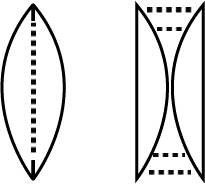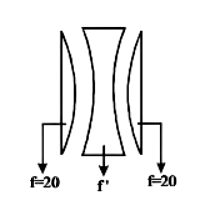
A thin convex lens of focal length 10 cm and refractive index 1.5 is cut vertically into two equal pieces. They are placed as shown with a liquid of refractive index 3 between them. What is the focal length of the combination?

A. $-10$ cm
B. $-\dfrac{10}{4}$ cm
C. $-\dfrac{10}{3}$cm
D. none
Answer
218.7k+ views
Hint:Here a thin convex lens is cut vertically into two equal pieces and they are combined together. A liquid is placed between two pieces. We have to find the focal length of the combination. Recall lens makers formula and concepts of combination of lenses. Apply it to find the focal length of the combination.
Formula used:
Lens makers formula:
$\dfrac{1}{f}=(\mu -1)\left( \dfrac{1}{{{r}_{1}}}-\dfrac{1}{{{r}_{2}}} \right)$
Where f= focal length, μ=refractive index, r1, r2=radius of curvature of both sides.
Complete step by step solution:
A thin convex lens of focal length of 10 cm and refractive index of convex lens 1.5 is cut vertically into two equal pieces. It is given that a liquid of refractive index of 3 is placed between lenses as shown in the figure. We have to find the focal length of this combination of lens.
For finding it we can divide this combination into three parts:
Two plano convex lenses and in the middle there is a concave lens formed. A thin convex lens is vertically cut into two equal parts that means the planoconvex lens formed has focal length 20 cm. Now using the lens maker's formula, we find the focal length of the concave lens formed between both plano convex lenses.
$\dfrac{1}{f}=(\mu -1)\left( \dfrac{1}{{{r}_{1}}}-\dfrac{1}{{{r}_{2}}} \right)$
Here both radius of curvature is same but with negative sign:
${{r}_{1}}={{r}_{2}}=10$cm
$\dfrac{1}{f}=(3-1)\left( -\dfrac{1}{10}-\dfrac{1}{10} \right)=-\dfrac{4}{10}$
Therefore, focal length of concave lens, $f=-\dfrac{10}{4}$ cm
Now for finding focal length of the combination we have:
$\dfrac{1}{{{f}_{combination}}}=\dfrac{1}{20}-\dfrac{4}{10}+\dfrac{1}{20}=-\dfrac{3}{10}cm$
Focal length of combination, ${{f}_{combination}}=-\dfrac{10}{3}cm$

Therefore, the answer is option C.
Notes: Remember when a convex lens is vertically cut into two equal parts focal length doubles. We have to know the relation between radius of curvature and focal length to solve this problem. Sign convention is also important.
Formula used:
Lens makers formula:
$\dfrac{1}{f}=(\mu -1)\left( \dfrac{1}{{{r}_{1}}}-\dfrac{1}{{{r}_{2}}} \right)$
Where f= focal length, μ=refractive index, r1, r2=radius of curvature of both sides.
Complete step by step solution:
A thin convex lens of focal length of 10 cm and refractive index of convex lens 1.5 is cut vertically into two equal pieces. It is given that a liquid of refractive index of 3 is placed between lenses as shown in the figure. We have to find the focal length of this combination of lens.
For finding it we can divide this combination into three parts:
Two plano convex lenses and in the middle there is a concave lens formed. A thin convex lens is vertically cut into two equal parts that means the planoconvex lens formed has focal length 20 cm. Now using the lens maker's formula, we find the focal length of the concave lens formed between both plano convex lenses.
$\dfrac{1}{f}=(\mu -1)\left( \dfrac{1}{{{r}_{1}}}-\dfrac{1}{{{r}_{2}}} \right)$
Here both radius of curvature is same but with negative sign:
${{r}_{1}}={{r}_{2}}=10$cm
$\dfrac{1}{f}=(3-1)\left( -\dfrac{1}{10}-\dfrac{1}{10} \right)=-\dfrac{4}{10}$
Therefore, focal length of concave lens, $f=-\dfrac{10}{4}$ cm
Now for finding focal length of the combination we have:
$\dfrac{1}{{{f}_{combination}}}=\dfrac{1}{20}-\dfrac{4}{10}+\dfrac{1}{20}=-\dfrac{3}{10}cm$
Focal length of combination, ${{f}_{combination}}=-\dfrac{10}{3}cm$

Therefore, the answer is option C.
Notes: Remember when a convex lens is vertically cut into two equal parts focal length doubles. We have to know the relation between radius of curvature and focal length to solve this problem. Sign convention is also important.
Recently Updated Pages
A square frame of side 10 cm and a long straight wire class 12 physics JEE_Main

The work done in slowly moving an electron of charge class 12 physics JEE_Main

Two identical charged spheres suspended from a common class 12 physics JEE_Main

According to Bohrs theory the timeaveraged magnetic class 12 physics JEE_Main

ill in the blanks Pure tungsten has A Low resistivity class 12 physics JEE_Main

The value of the resistor RS needed in the DC voltage class 12 physics JEE_Main

Trending doubts
JEE Main 2026: Application Form Open, Exam Dates, Syllabus, Eligibility & Question Papers

Derivation of Equation of Trajectory Explained for Students

Hybridisation in Chemistry – Concept, Types & Applications

Understanding the Angle of Deviation in a Prism

Understanding Collisions: Types and Examples for Students

Understanding Atomic Structure for Beginners

Other Pages
JEE Advanced Marks vs Ranks 2025: Understanding Category-wise Qualifying Marks and Previous Year Cut-offs

How to Convert a Galvanometer into an Ammeter or Voltmeter

Understanding Centrifugal Force in Physics

JEE Main Marking Scheme 2026- Paper-Wise Marks Distribution and Negative Marking Details

Degree of Dissociation: Meaning, Formula, Calculation & Uses

Understanding Electromagnetic Waves and Their Importance




